The analysis of accountability documentation
VerifiedAdded on 2022/09/13
|12
|3395
|10
AI Summary
Contribute Materials
Your contribution can guide someone’s learning journey. Share your
documents today.
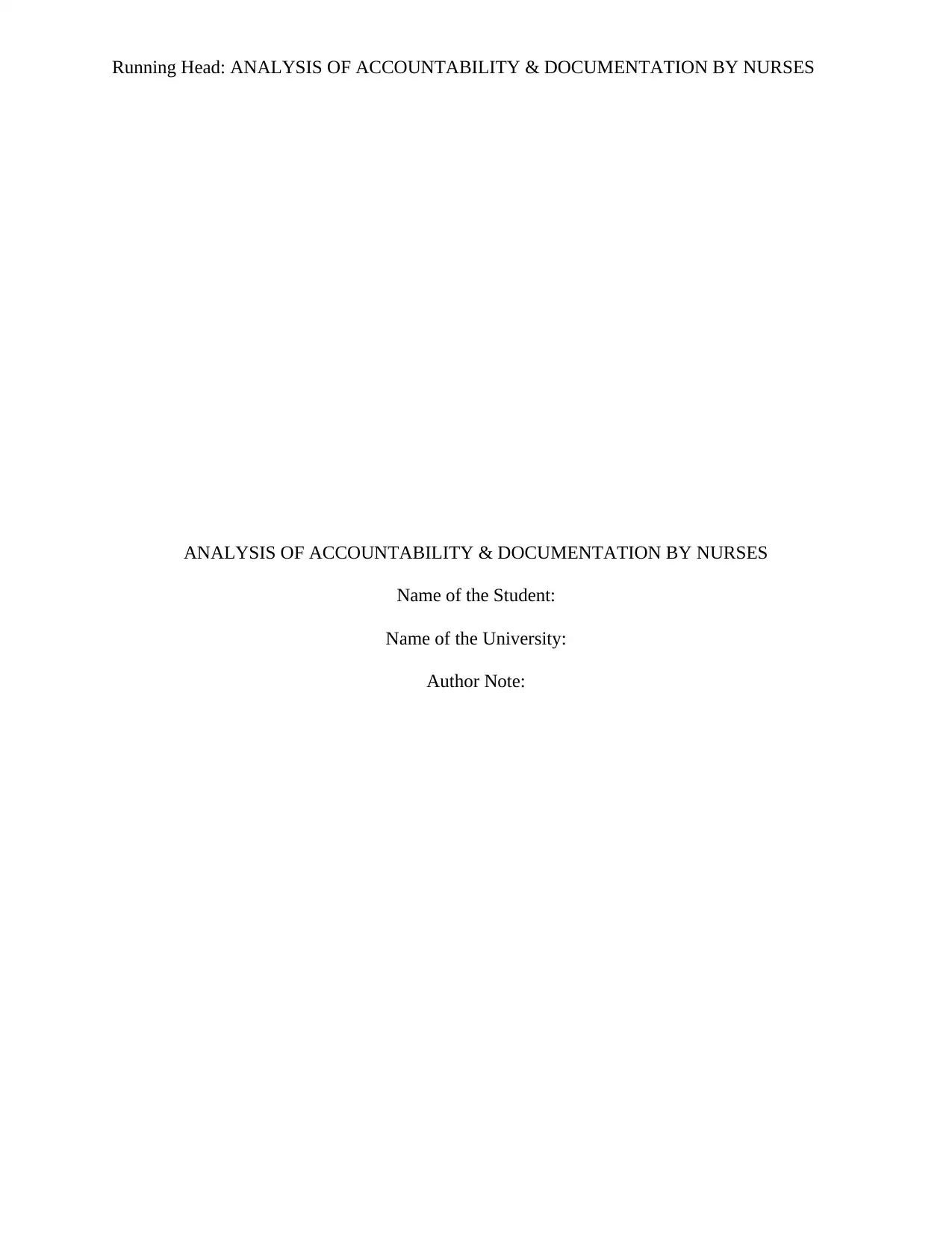
Running Head: ANALYSIS OF ACCOUNTABILITY & DOCUMENTATION BY NURSES
ANALYSIS OF ACCOUNTABILITY & DOCUMENTATION BY NURSES
Name of the Student:
Name of the University:
Author Note:
ANALYSIS OF ACCOUNTABILITY & DOCUMENTATION BY NURSES
Name of the Student:
Name of the University:
Author Note:
Secure Best Marks with AI Grader
Need help grading? Try our AI Grader for instant feedback on your assignments.
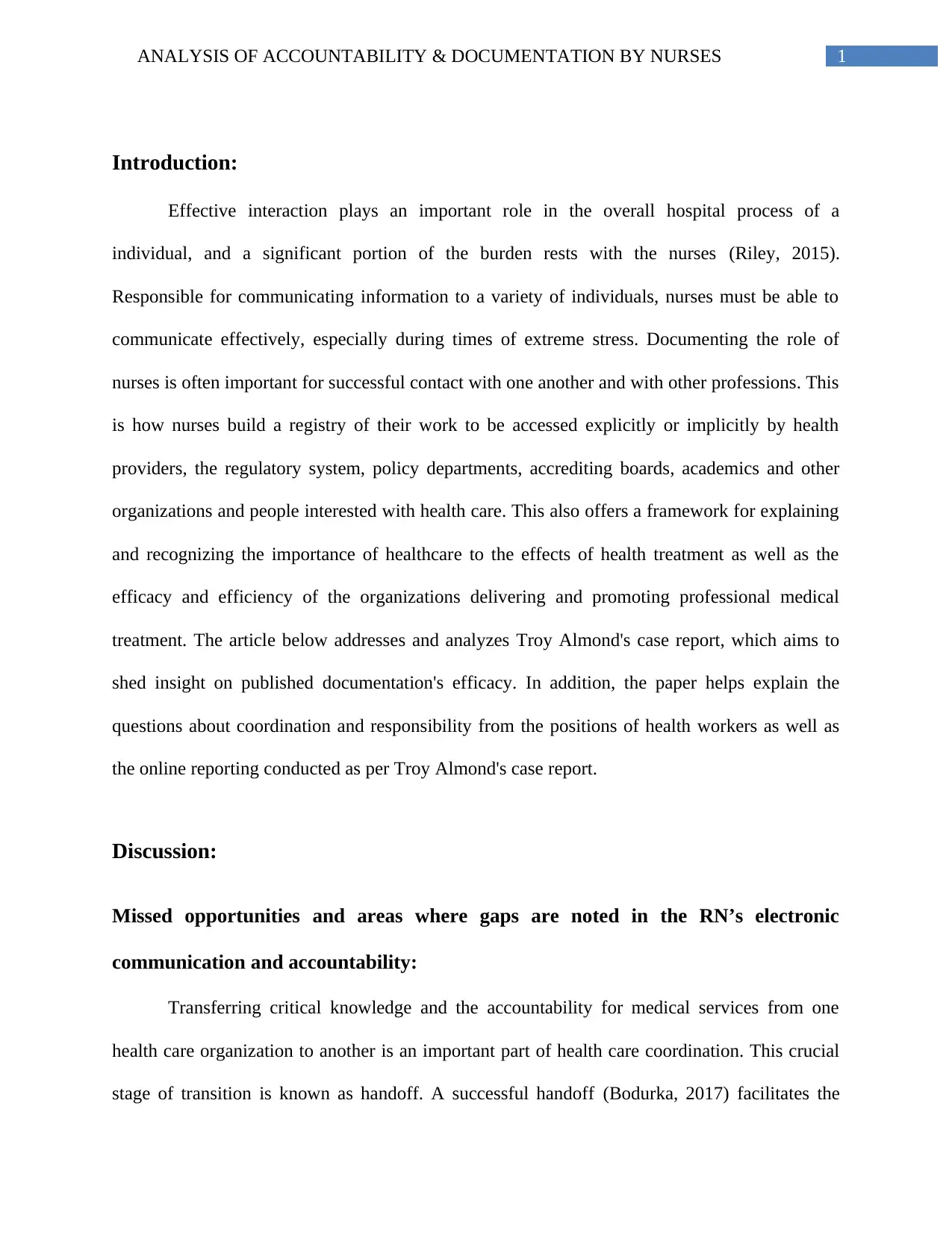
1ANALYSIS OF ACCOUNTABILITY & DOCUMENTATION BY NURSES
Introduction:
Effective interaction plays an important role in the overall hospital process of a
individual, and a significant portion of the burden rests with the nurses (Riley, 2015).
Responsible for communicating information to a variety of individuals, nurses must be able to
communicate effectively, especially during times of extreme stress. Documenting the role of
nurses is often important for successful contact with one another and with other professions. This
is how nurses build a registry of their work to be accessed explicitly or implicitly by health
providers, the regulatory system, policy departments, accrediting boards, academics and other
organizations and people interested with health care. This also offers a framework for explaining
and recognizing the importance of healthcare to the effects of health treatment as well as the
efficacy and efficiency of the organizations delivering and promoting professional medical
treatment. The article below addresses and analyzes Troy Almond's case report, which aims to
shed insight on published documentation's efficacy. In addition, the paper helps explain the
questions about coordination and responsibility from the positions of health workers as well as
the online reporting conducted as per Troy Almond's case report.
Discussion:
Missed opportunities and areas where gaps are noted in the RN’s electronic
communication and accountability:
Transferring critical knowledge and the accountability for medical services from one
health care organization to another is an important part of health care coordination. This crucial
stage of transition is known as handoff. A successful handoff (Bodurka, 2017) facilitates the
Introduction:
Effective interaction plays an important role in the overall hospital process of a
individual, and a significant portion of the burden rests with the nurses (Riley, 2015).
Responsible for communicating information to a variety of individuals, nurses must be able to
communicate effectively, especially during times of extreme stress. Documenting the role of
nurses is often important for successful contact with one another and with other professions. This
is how nurses build a registry of their work to be accessed explicitly or implicitly by health
providers, the regulatory system, policy departments, accrediting boards, academics and other
organizations and people interested with health care. This also offers a framework for explaining
and recognizing the importance of healthcare to the effects of health treatment as well as the
efficacy and efficiency of the organizations delivering and promoting professional medical
treatment. The article below addresses and analyzes Troy Almond's case report, which aims to
shed insight on published documentation's efficacy. In addition, the paper helps explain the
questions about coordination and responsibility from the positions of health workers as well as
the online reporting conducted as per Troy Almond's case report.
Discussion:
Missed opportunities and areas where gaps are noted in the RN’s electronic
communication and accountability:
Transferring critical knowledge and the accountability for medical services from one
health care organization to another is an important part of health care coordination. This crucial
stage of transition is known as handoff. A successful handoff (Bodurka, 2017) facilitates the
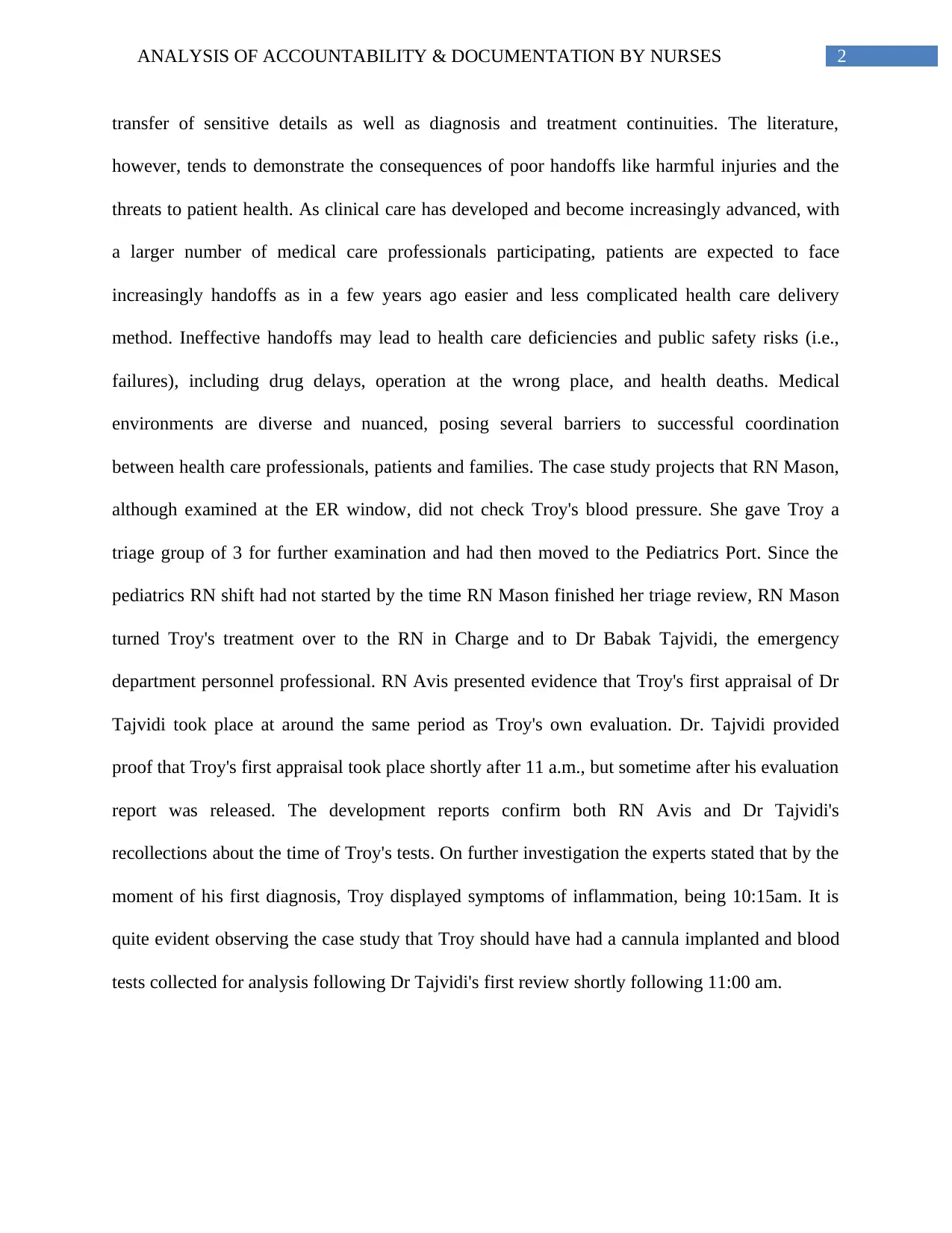
2ANALYSIS OF ACCOUNTABILITY & DOCUMENTATION BY NURSES
transfer of sensitive details as well as diagnosis and treatment continuities. The literature,
however, tends to demonstrate the consequences of poor handoffs like harmful injuries and the
threats to patient health. As clinical care has developed and become increasingly advanced, with
a larger number of medical care professionals participating, patients are expected to face
increasingly handoffs as in a few years ago easier and less complicated health care delivery
method. Ineffective handoffs may lead to health care deficiencies and public safety risks (i.e.,
failures), including drug delays, operation at the wrong place, and health deaths. Medical
environments are diverse and nuanced, posing several barriers to successful coordination
between health care professionals, patients and families. The case study projects that RN Mason,
although examined at the ER window, did not check Troy's blood pressure. She gave Troy a
triage group of 3 for further examination and had then moved to the Pediatrics Port. Since the
pediatrics RN shift had not started by the time RN Mason finished her triage review, RN Mason
turned Troy's treatment over to the RN in Charge and to Dr Babak Tajvidi, the emergency
department personnel professional. RN Avis presented evidence that Troy's first appraisal of Dr
Tajvidi took place at around the same period as Troy's own evaluation. Dr. Tajvidi provided
proof that Troy's first appraisal took place shortly after 11 a.m., but sometime after his evaluation
report was released. The development reports confirm both RN Avis and Dr Tajvidi's
recollections about the time of Troy's tests. On further investigation the experts stated that by the
moment of his first diagnosis, Troy displayed symptoms of inflammation, being 10:15am. It is
quite evident observing the case study that Troy should have had a cannula implanted and blood
tests collected for analysis following Dr Tajvidi's first review shortly following 11:00 am.
transfer of sensitive details as well as diagnosis and treatment continuities. The literature,
however, tends to demonstrate the consequences of poor handoffs like harmful injuries and the
threats to patient health. As clinical care has developed and become increasingly advanced, with
a larger number of medical care professionals participating, patients are expected to face
increasingly handoffs as in a few years ago easier and less complicated health care delivery
method. Ineffective handoffs may lead to health care deficiencies and public safety risks (i.e.,
failures), including drug delays, operation at the wrong place, and health deaths. Medical
environments are diverse and nuanced, posing several barriers to successful coordination
between health care professionals, patients and families. The case study projects that RN Mason,
although examined at the ER window, did not check Troy's blood pressure. She gave Troy a
triage group of 3 for further examination and had then moved to the Pediatrics Port. Since the
pediatrics RN shift had not started by the time RN Mason finished her triage review, RN Mason
turned Troy's treatment over to the RN in Charge and to Dr Babak Tajvidi, the emergency
department personnel professional. RN Avis presented evidence that Troy's first appraisal of Dr
Tajvidi took place at around the same period as Troy's own evaluation. Dr. Tajvidi provided
proof that Troy's first appraisal took place shortly after 11 a.m., but sometime after his evaluation
report was released. The development reports confirm both RN Avis and Dr Tajvidi's
recollections about the time of Troy's tests. On further investigation the experts stated that by the
moment of his first diagnosis, Troy displayed symptoms of inflammation, being 10:15am. It is
quite evident observing the case study that Troy should have had a cannula implanted and blood
tests collected for analysis following Dr Tajvidi's first review shortly following 11:00 am.
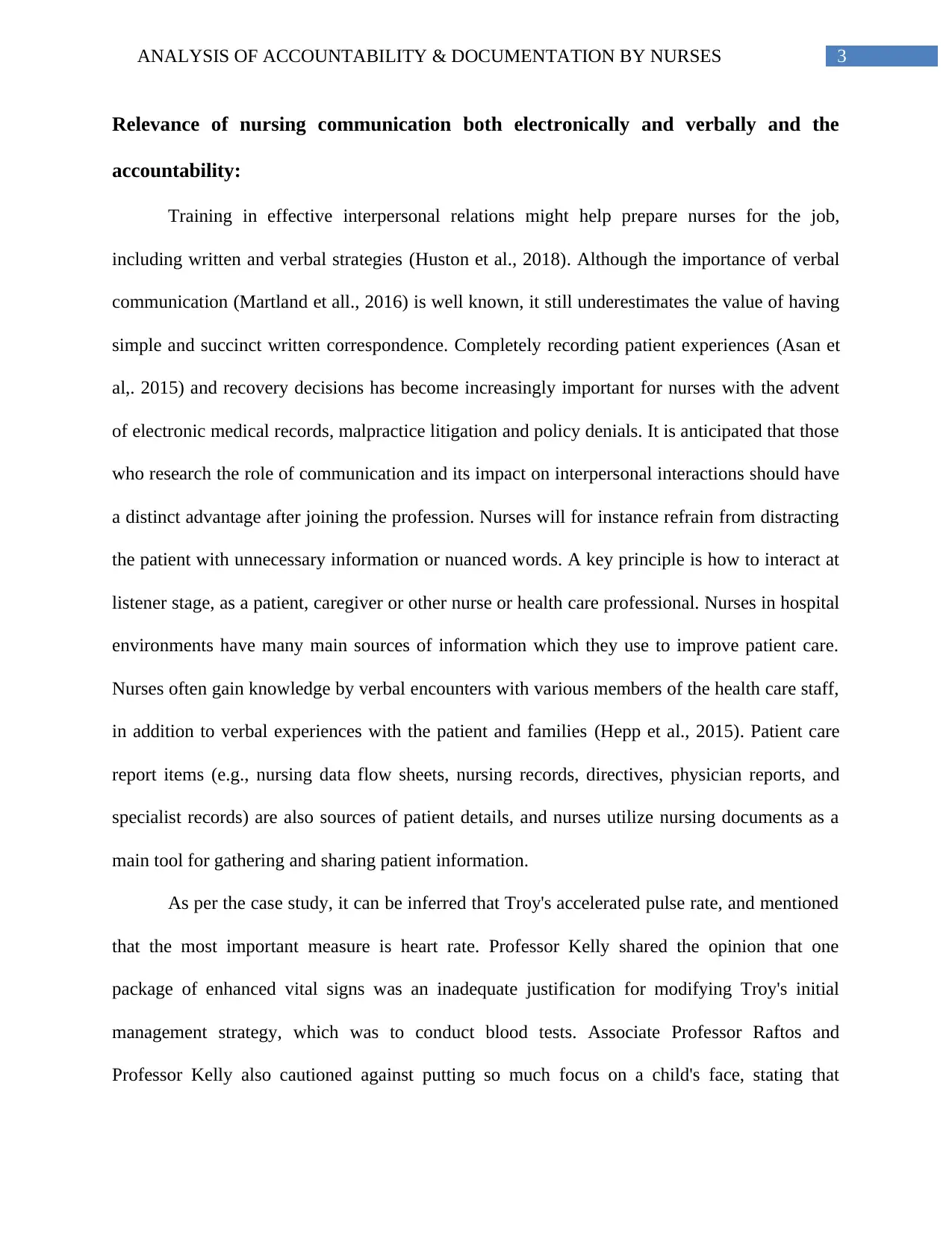
3ANALYSIS OF ACCOUNTABILITY & DOCUMENTATION BY NURSES
Relevance of nursing communication both electronically and verbally and the
accountability:
Training in effective interpersonal relations might help prepare nurses for the job,
including written and verbal strategies (Huston et al., 2018). Although the importance of verbal
communication (Martland et all., 2016) is well known, it still underestimates the value of having
simple and succinct written correspondence. Completely recording patient experiences (Asan et
al,. 2015) and recovery decisions has become increasingly important for nurses with the advent
of electronic medical records, malpractice litigation and policy denials. It is anticipated that those
who research the role of communication and its impact on interpersonal interactions should have
a distinct advantage after joining the profession. Nurses will for instance refrain from distracting
the patient with unnecessary information or nuanced words. A key principle is how to interact at
listener stage, as a patient, caregiver or other nurse or health care professional. Nurses in hospital
environments have many main sources of information which they use to improve patient care.
Nurses often gain knowledge by verbal encounters with various members of the health care staff,
in addition to verbal experiences with the patient and families (Hepp et al., 2015). Patient care
report items (e.g., nursing data flow sheets, nursing records, directives, physician reports, and
specialist records) are also sources of patient details, and nurses utilize nursing documents as a
main tool for gathering and sharing patient information.
As per the case study, it can be inferred that Troy's accelerated pulse rate, and mentioned
that the most important measure is heart rate. Professor Kelly shared the opinion that one
package of enhanced vital signs was an inadequate justification for modifying Troy's initial
management strategy, which was to conduct blood tests. Associate Professor Raftos and
Professor Kelly also cautioned against putting so much focus on a child's face, stating that
Relevance of nursing communication both electronically and verbally and the
accountability:
Training in effective interpersonal relations might help prepare nurses for the job,
including written and verbal strategies (Huston et al., 2018). Although the importance of verbal
communication (Martland et all., 2016) is well known, it still underestimates the value of having
simple and succinct written correspondence. Completely recording patient experiences (Asan et
al,. 2015) and recovery decisions has become increasingly important for nurses with the advent
of electronic medical records, malpractice litigation and policy denials. It is anticipated that those
who research the role of communication and its impact on interpersonal interactions should have
a distinct advantage after joining the profession. Nurses will for instance refrain from distracting
the patient with unnecessary information or nuanced words. A key principle is how to interact at
listener stage, as a patient, caregiver or other nurse or health care professional. Nurses in hospital
environments have many main sources of information which they use to improve patient care.
Nurses often gain knowledge by verbal encounters with various members of the health care staff,
in addition to verbal experiences with the patient and families (Hepp et al., 2015). Patient care
report items (e.g., nursing data flow sheets, nursing records, directives, physician reports, and
specialist records) are also sources of patient details, and nurses utilize nursing documents as a
main tool for gathering and sharing patient information.
As per the case study, it can be inferred that Troy's accelerated pulse rate, and mentioned
that the most important measure is heart rate. Professor Kelly shared the opinion that one
package of enhanced vital signs was an inadequate justification for modifying Troy's initial
management strategy, which was to conduct blood tests. Associate Professor Raftos and
Professor Kelly also cautioned against putting so much focus on a child's face, stating that
Secure Best Marks with AI Grader
Need help grading? Try our AI Grader for instant feedback on your assignments.
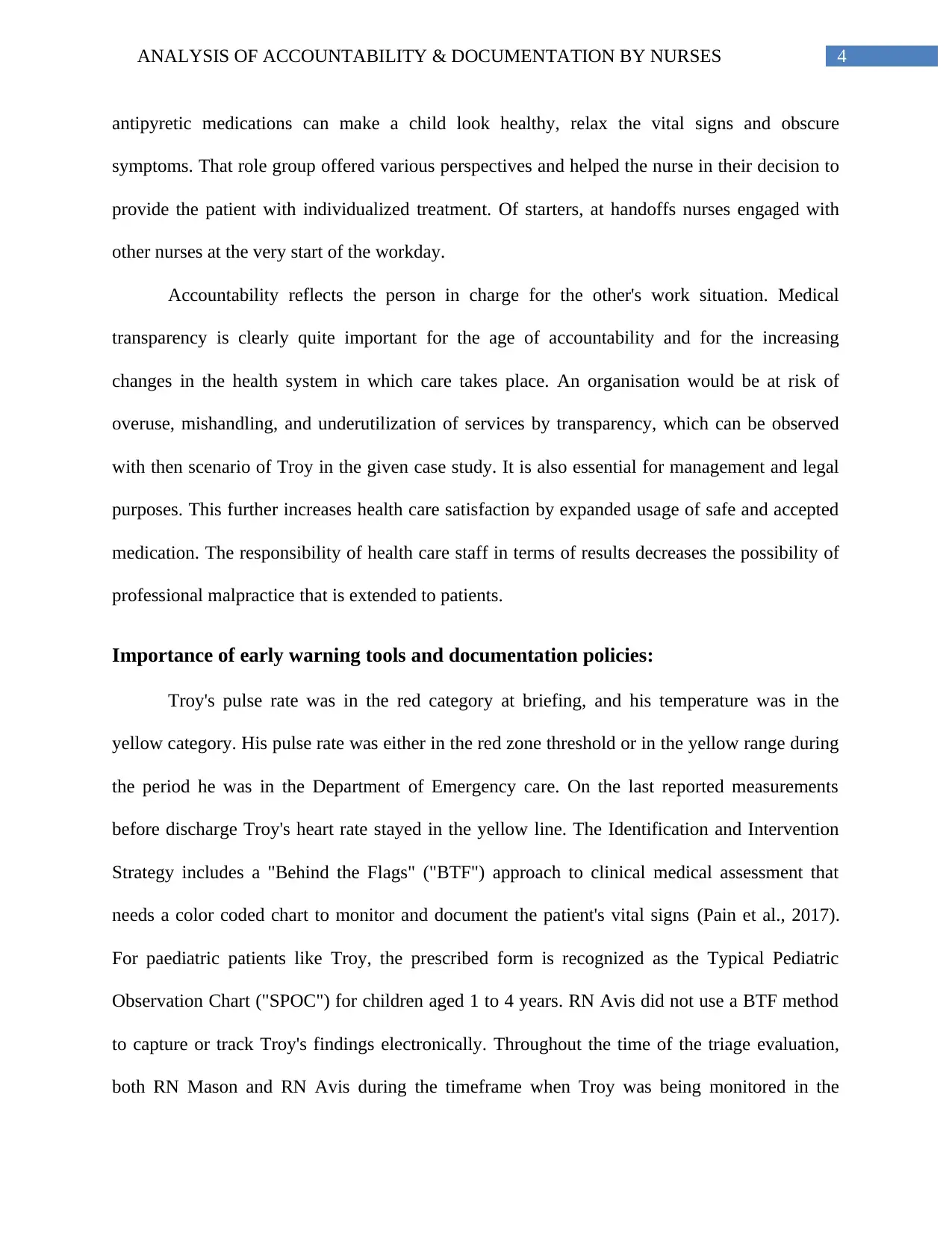
4ANALYSIS OF ACCOUNTABILITY & DOCUMENTATION BY NURSES
antipyretic medications can make a child look healthy, relax the vital signs and obscure
symptoms. That role group offered various perspectives and helped the nurse in their decision to
provide the patient with individualized treatment. Of starters, at handoffs nurses engaged with
other nurses at the very start of the workday.
Accountability reflects the person in charge for the other's work situation. Medical
transparency is clearly quite important for the age of accountability and for the increasing
changes in the health system in which care takes place. An organisation would be at risk of
overuse, mishandling, and underutilization of services by transparency, which can be observed
with then scenario of Troy in the given case study. It is also essential for management and legal
purposes. This further increases health care satisfaction by expanded usage of safe and accepted
medication. The responsibility of health care staff in terms of results decreases the possibility of
professional malpractice that is extended to patients.
Importance of early warning tools and documentation policies:
Troy's pulse rate was in the red category at briefing, and his temperature was in the
yellow category. His pulse rate was either in the red zone threshold or in the yellow range during
the period he was in the Department of Emergency care. On the last reported measurements
before discharge Troy's heart rate stayed in the yellow line. The Identification and Intervention
Strategy includes a "Behind the Flags" ("BTF") approach to clinical medical assessment that
needs a color coded chart to monitor and document the patient's vital signs (Pain et al., 2017).
For paediatric patients like Troy, the prescribed form is recognized as the Typical Pediatric
Observation Chart ("SPOC") for children aged 1 to 4 years. RN Avis did not use a BTF method
to capture or track Troy's findings electronically. Throughout the time of the triage evaluation,
both RN Mason and RN Avis during the timeframe when Troy was being monitored in the
antipyretic medications can make a child look healthy, relax the vital signs and obscure
symptoms. That role group offered various perspectives and helped the nurse in their decision to
provide the patient with individualized treatment. Of starters, at handoffs nurses engaged with
other nurses at the very start of the workday.
Accountability reflects the person in charge for the other's work situation. Medical
transparency is clearly quite important for the age of accountability and for the increasing
changes in the health system in which care takes place. An organisation would be at risk of
overuse, mishandling, and underutilization of services by transparency, which can be observed
with then scenario of Troy in the given case study. It is also essential for management and legal
purposes. This further increases health care satisfaction by expanded usage of safe and accepted
medication. The responsibility of health care staff in terms of results decreases the possibility of
professional malpractice that is extended to patients.
Importance of early warning tools and documentation policies:
Troy's pulse rate was in the red category at briefing, and his temperature was in the
yellow category. His pulse rate was either in the red zone threshold or in the yellow range during
the period he was in the Department of Emergency care. On the last reported measurements
before discharge Troy's heart rate stayed in the yellow line. The Identification and Intervention
Strategy includes a "Behind the Flags" ("BTF") approach to clinical medical assessment that
needs a color coded chart to monitor and document the patient's vital signs (Pain et al., 2017).
For paediatric patients like Troy, the prescribed form is recognized as the Typical Pediatric
Observation Chart ("SPOC") for children aged 1 to 4 years. RN Avis did not use a BTF method
to capture or track Troy's findings electronically. Throughout the time of the triage evaluation,
both RN Mason and RN Avis during the timeframe when Troy was being monitored in the
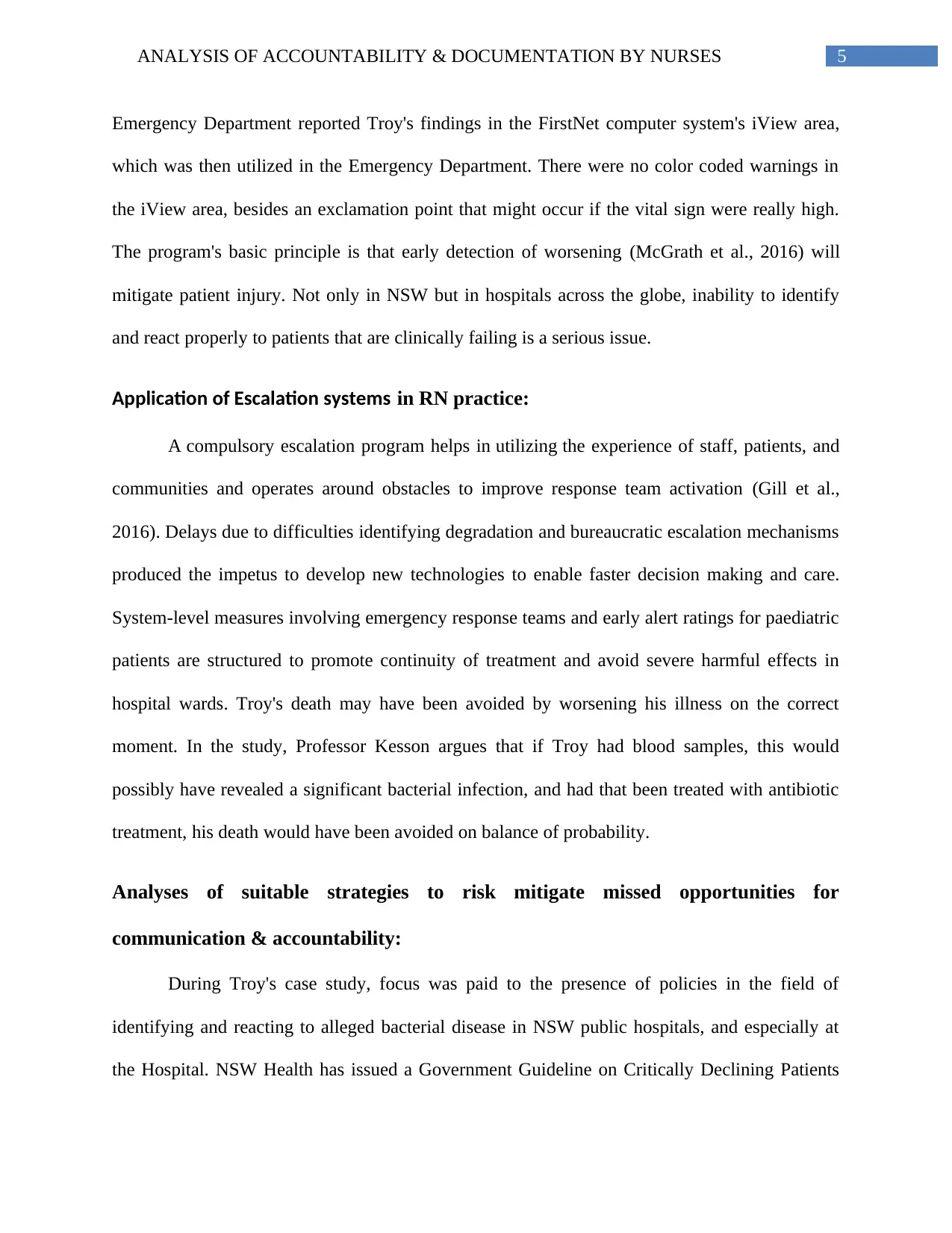
5ANALYSIS OF ACCOUNTABILITY & DOCUMENTATION BY NURSES
Emergency Department reported Troy's findings in the FirstNet computer system's iView area,
which was then utilized in the Emergency Department. There were no color coded warnings in
the iView area, besides an exclamation point that might occur if the vital sign were really high.
The program's basic principle is that early detection of worsening (McGrath et al., 2016) will
mitigate patient injury. Not only in NSW but in hospitals across the globe, inability to identify
and react properly to patients that are clinically failing is a serious issue.
Application of Escalation systems in RN practice:
A compulsory escalation program helps in utilizing the experience of staff, patients, and
communities and operates around obstacles to improve response team activation (Gill et al.,
2016). Delays due to difficulties identifying degradation and bureaucratic escalation mechanisms
produced the impetus to develop new technologies to enable faster decision making and care.
System-level measures involving emergency response teams and early alert ratings for paediatric
patients are structured to promote continuity of treatment and avoid severe harmful effects in
hospital wards. Troy's death may have been avoided by worsening his illness on the correct
moment. In the study, Professor Kesson argues that if Troy had blood samples, this would
possibly have revealed a significant bacterial infection, and had that been treated with antibiotic
treatment, his death would have been avoided on balance of probability.
Analyses of suitable strategies to risk mitigate missed opportunities for
communication & accountability:
During Troy's case study, focus was paid to the presence of policies in the field of
identifying and reacting to alleged bacterial disease in NSW public hospitals, and especially at
the Hospital. NSW Health has issued a Government Guideline on Critically Declining Patients
Emergency Department reported Troy's findings in the FirstNet computer system's iView area,
which was then utilized in the Emergency Department. There were no color coded warnings in
the iView area, besides an exclamation point that might occur if the vital sign were really high.
The program's basic principle is that early detection of worsening (McGrath et al., 2016) will
mitigate patient injury. Not only in NSW but in hospitals across the globe, inability to identify
and react properly to patients that are clinically failing is a serious issue.
Application of Escalation systems in RN practice:
A compulsory escalation program helps in utilizing the experience of staff, patients, and
communities and operates around obstacles to improve response team activation (Gill et al.,
2016). Delays due to difficulties identifying degradation and bureaucratic escalation mechanisms
produced the impetus to develop new technologies to enable faster decision making and care.
System-level measures involving emergency response teams and early alert ratings for paediatric
patients are structured to promote continuity of treatment and avoid severe harmful effects in
hospital wards. Troy's death may have been avoided by worsening his illness on the correct
moment. In the study, Professor Kesson argues that if Troy had blood samples, this would
possibly have revealed a significant bacterial infection, and had that been treated with antibiotic
treatment, his death would have been avoided on balance of probability.
Analyses of suitable strategies to risk mitigate missed opportunities for
communication & accountability:
During Troy's case study, focus was paid to the presence of policies in the field of
identifying and reacting to alleged bacterial disease in NSW public hospitals, and especially at
the Hospital. NSW Health has issued a Government Guideline on Critically Declining Patients
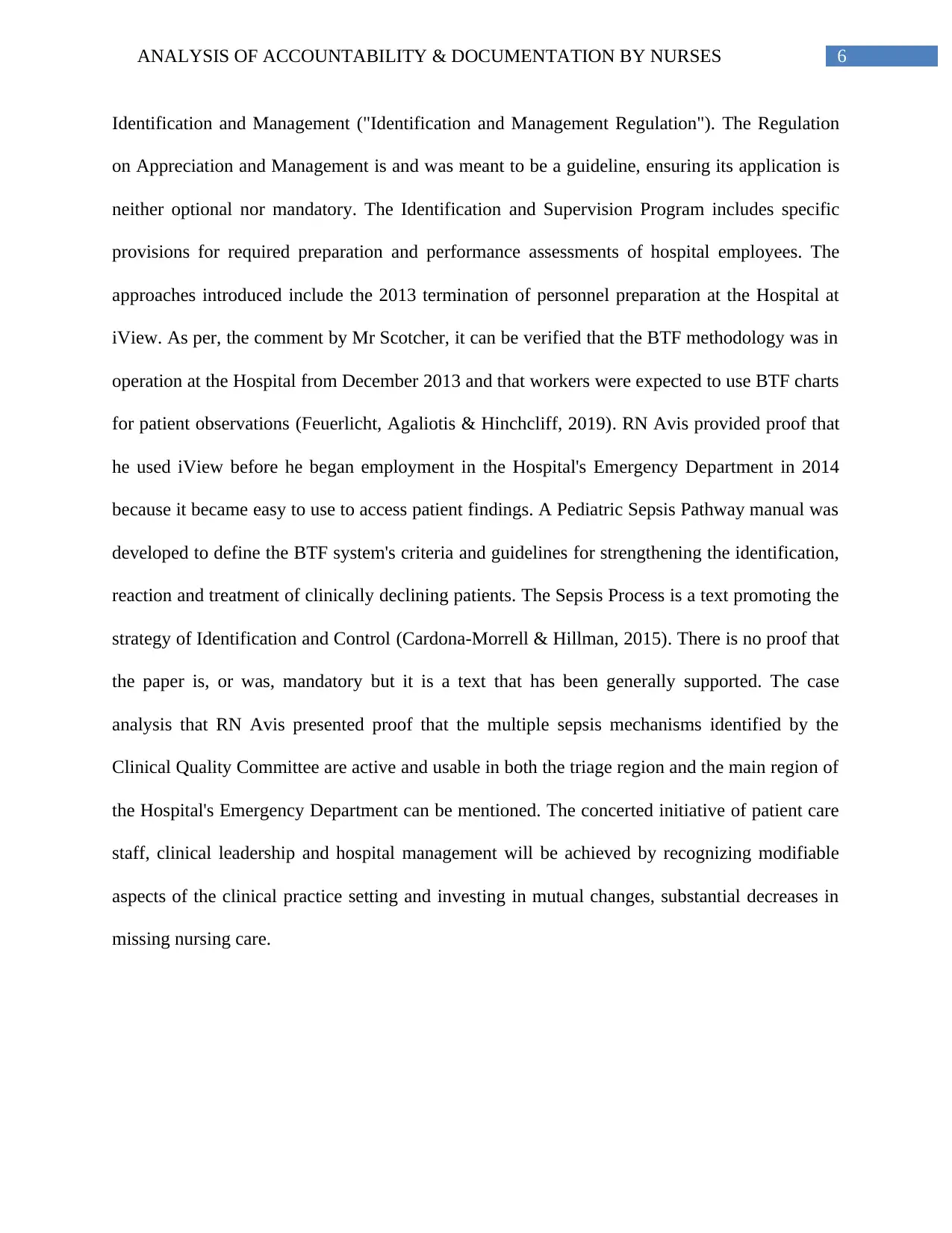
6ANALYSIS OF ACCOUNTABILITY & DOCUMENTATION BY NURSES
Identification and Management ("Identification and Management Regulation"). The Regulation
on Appreciation and Management is and was meant to be a guideline, ensuring its application is
neither optional nor mandatory. The Identification and Supervision Program includes specific
provisions for required preparation and performance assessments of hospital employees. The
approaches introduced include the 2013 termination of personnel preparation at the Hospital at
iView. As per, the comment by Mr Scotcher, it can be verified that the BTF methodology was in
operation at the Hospital from December 2013 and that workers were expected to use BTF charts
for patient observations (Feuerlicht, Agaliotis & Hinchcliff, 2019). RN Avis provided proof that
he used iView before he began employment in the Hospital's Emergency Department in 2014
because it became easy to use to access patient findings. A Pediatric Sepsis Pathway manual was
developed to define the BTF system's criteria and guidelines for strengthening the identification,
reaction and treatment of clinically declining patients. The Sepsis Process is a text promoting the
strategy of Identification and Control (Cardona-Morrell & Hillman, 2015). There is no proof that
the paper is, or was, mandatory but it is a text that has been generally supported. The case
analysis that RN Avis presented proof that the multiple sepsis mechanisms identified by the
Clinical Quality Committee are active and usable in both the triage region and the main region of
the Hospital's Emergency Department can be mentioned. The concerted initiative of patient care
staff, clinical leadership and hospital management will be achieved by recognizing modifiable
aspects of the clinical practice setting and investing in mutual changes, substantial decreases in
missing nursing care.
Identification and Management ("Identification and Management Regulation"). The Regulation
on Appreciation and Management is and was meant to be a guideline, ensuring its application is
neither optional nor mandatory. The Identification and Supervision Program includes specific
provisions for required preparation and performance assessments of hospital employees. The
approaches introduced include the 2013 termination of personnel preparation at the Hospital at
iView. As per, the comment by Mr Scotcher, it can be verified that the BTF methodology was in
operation at the Hospital from December 2013 and that workers were expected to use BTF charts
for patient observations (Feuerlicht, Agaliotis & Hinchcliff, 2019). RN Avis provided proof that
he used iView before he began employment in the Hospital's Emergency Department in 2014
because it became easy to use to access patient findings. A Pediatric Sepsis Pathway manual was
developed to define the BTF system's criteria and guidelines for strengthening the identification,
reaction and treatment of clinically declining patients. The Sepsis Process is a text promoting the
strategy of Identification and Control (Cardona-Morrell & Hillman, 2015). There is no proof that
the paper is, or was, mandatory but it is a text that has been generally supported. The case
analysis that RN Avis presented proof that the multiple sepsis mechanisms identified by the
Clinical Quality Committee are active and usable in both the triage region and the main region of
the Hospital's Emergency Department can be mentioned. The concerted initiative of patient care
staff, clinical leadership and hospital management will be achieved by recognizing modifiable
aspects of the clinical practice setting and investing in mutual changes, substantial decreases in
missing nursing care.
Paraphrase This Document
Need a fresh take? Get an instant paraphrase of this document with our AI Paraphraser
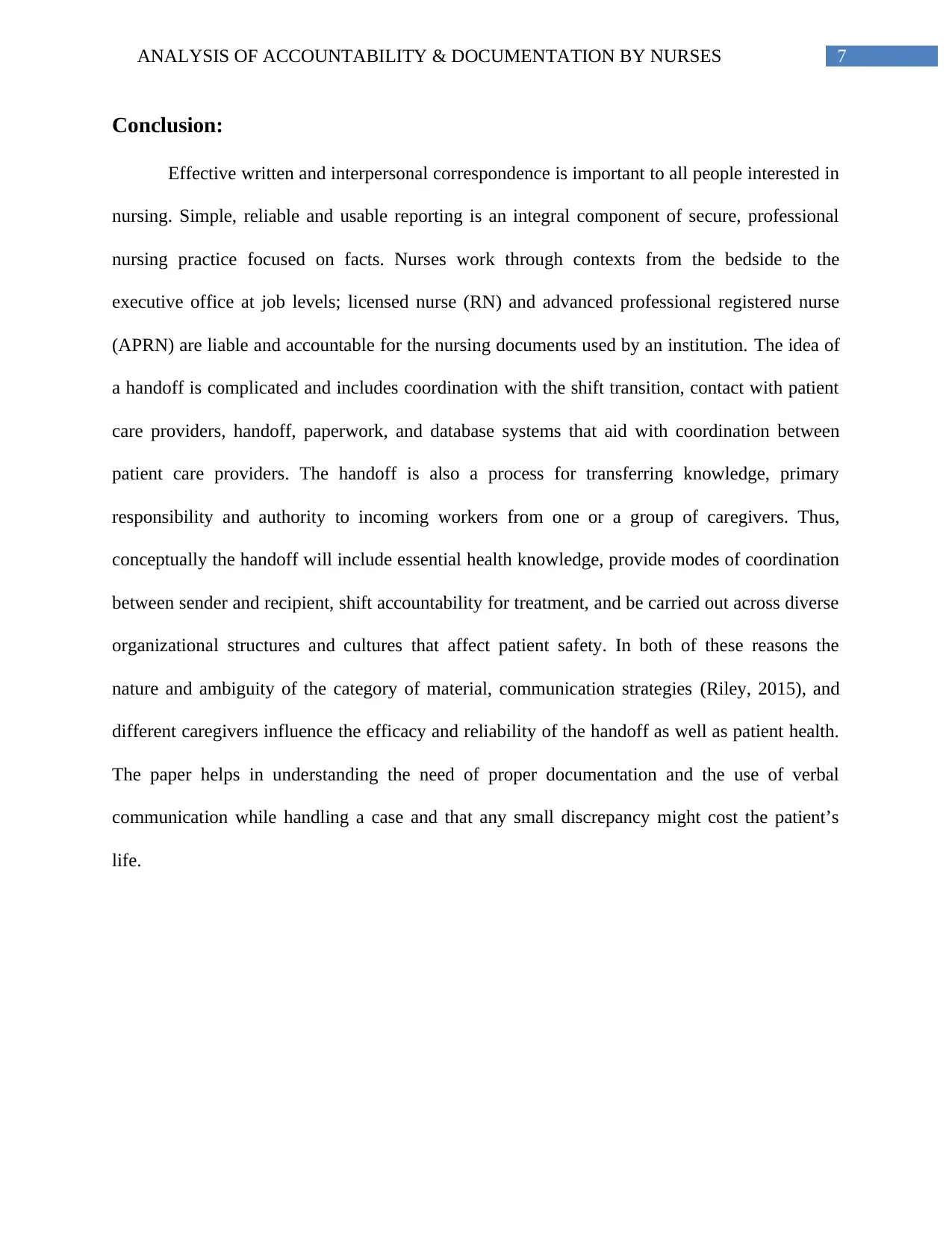
7ANALYSIS OF ACCOUNTABILITY & DOCUMENTATION BY NURSES
Conclusion:
Effective written and interpersonal correspondence is important to all people interested in
nursing. Simple, reliable and usable reporting is an integral component of secure, professional
nursing practice focused on facts. Nurses work through contexts from the bedside to the
executive office at job levels; licensed nurse (RN) and advanced professional registered nurse
(APRN) are liable and accountable for the nursing documents used by an institution. The idea of
a handoff is complicated and includes coordination with the shift transition, contact with patient
care providers, handoff, paperwork, and database systems that aid with coordination between
patient care providers. The handoff is also a process for transferring knowledge, primary
responsibility and authority to incoming workers from one or a group of caregivers. Thus,
conceptually the handoff will include essential health knowledge, provide modes of coordination
between sender and recipient, shift accountability for treatment, and be carried out across diverse
organizational structures and cultures that affect patient safety. In both of these reasons the
nature and ambiguity of the category of material, communication strategies (Riley, 2015), and
different caregivers influence the efficacy and reliability of the handoff as well as patient health.
The paper helps in understanding the need of proper documentation and the use of verbal
communication while handling a case and that any small discrepancy might cost the patient’s
life.
Conclusion:
Effective written and interpersonal correspondence is important to all people interested in
nursing. Simple, reliable and usable reporting is an integral component of secure, professional
nursing practice focused on facts. Nurses work through contexts from the bedside to the
executive office at job levels; licensed nurse (RN) and advanced professional registered nurse
(APRN) are liable and accountable for the nursing documents used by an institution. The idea of
a handoff is complicated and includes coordination with the shift transition, contact with patient
care providers, handoff, paperwork, and database systems that aid with coordination between
patient care providers. The handoff is also a process for transferring knowledge, primary
responsibility and authority to incoming workers from one or a group of caregivers. Thus,
conceptually the handoff will include essential health knowledge, provide modes of coordination
between sender and recipient, shift accountability for treatment, and be carried out across diverse
organizational structures and cultures that affect patient safety. In both of these reasons the
nature and ambiguity of the category of material, communication strategies (Riley, 2015), and
different caregivers influence the efficacy and reliability of the handoff as well as patient health.
The paper helps in understanding the need of proper documentation and the use of verbal
communication while handling a case and that any small discrepancy might cost the patient’s
life.
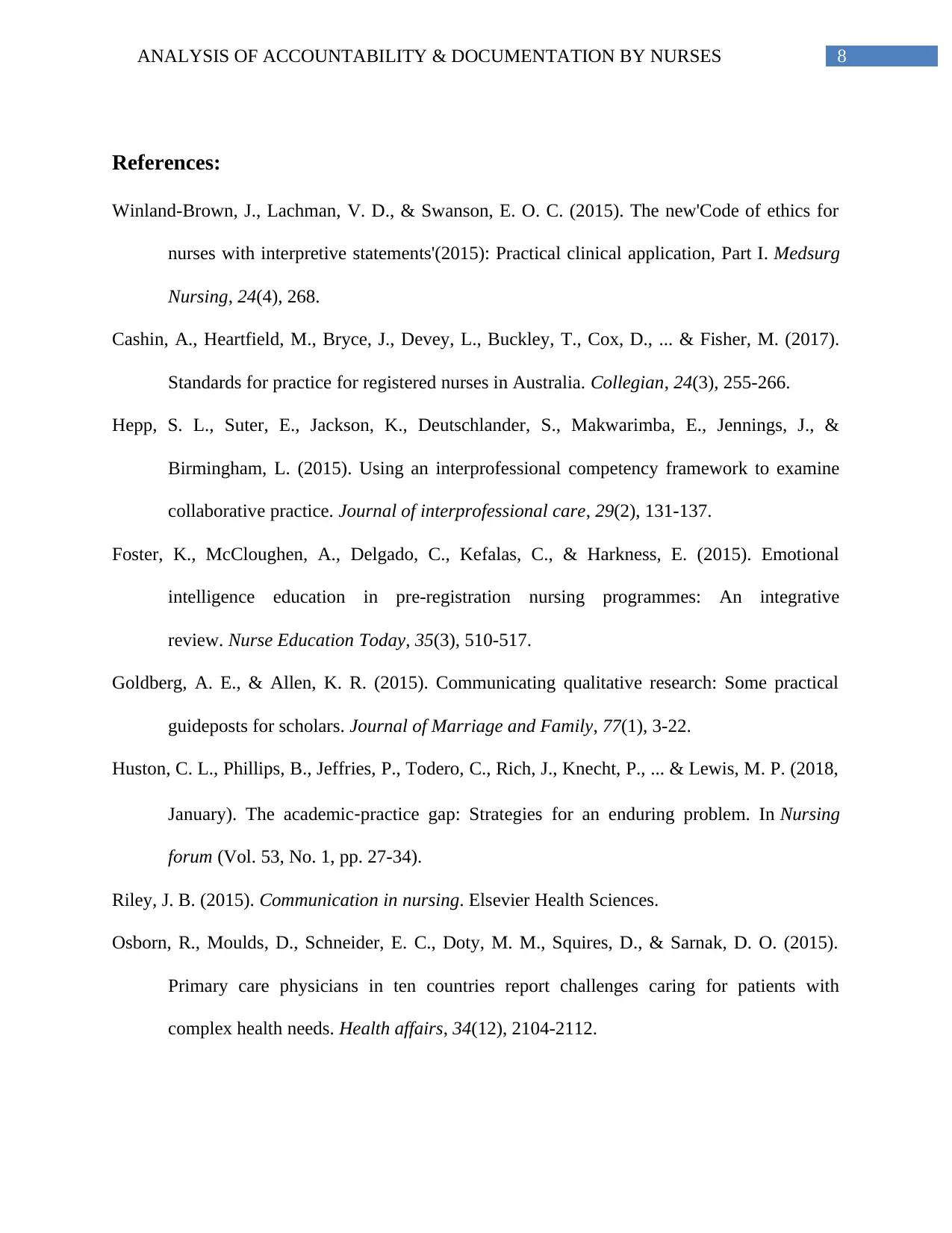
8ANALYSIS OF ACCOUNTABILITY & DOCUMENTATION BY NURSES
References:
Winland-Brown, J., Lachman, V. D., & Swanson, E. O. C. (2015). The new'Code of ethics for
nurses with interpretive statements'(2015): Practical clinical application, Part I. Medsurg
Nursing, 24(4), 268.
Cashin, A., Heartfield, M., Bryce, J., Devey, L., Buckley, T., Cox, D., ... & Fisher, M. (2017).
Standards for practice for registered nurses in Australia. Collegian, 24(3), 255-266.
Hepp, S. L., Suter, E., Jackson, K., Deutschlander, S., Makwarimba, E., Jennings, J., &
Birmingham, L. (2015). Using an interprofessional competency framework to examine
collaborative practice. Journal of interprofessional care, 29(2), 131-137.
Foster, K., McCloughen, A., Delgado, C., Kefalas, C., & Harkness, E. (2015). Emotional
intelligence education in pre-registration nursing programmes: An integrative
review. Nurse Education Today, 35(3), 510-517.
Goldberg, A. E., & Allen, K. R. (2015). Communicating qualitative research: Some practical
guideposts for scholars. Journal of Marriage and Family, 77(1), 3-22.
Huston, C. L., Phillips, B., Jeffries, P., Todero, C., Rich, J., Knecht, P., ... & Lewis, M. P. (2018,
January). The academic‐practice gap: Strategies for an enduring problem. In Nursing
forum (Vol. 53, No. 1, pp. 27-34).
Riley, J. B. (2015). Communication in nursing. Elsevier Health Sciences.
Osborn, R., Moulds, D., Schneider, E. C., Doty, M. M., Squires, D., & Sarnak, D. O. (2015).
Primary care physicians in ten countries report challenges caring for patients with
complex health needs. Health affairs, 34(12), 2104-2112.
References:
Winland-Brown, J., Lachman, V. D., & Swanson, E. O. C. (2015). The new'Code of ethics for
nurses with interpretive statements'(2015): Practical clinical application, Part I. Medsurg
Nursing, 24(4), 268.
Cashin, A., Heartfield, M., Bryce, J., Devey, L., Buckley, T., Cox, D., ... & Fisher, M. (2017).
Standards for practice for registered nurses in Australia. Collegian, 24(3), 255-266.
Hepp, S. L., Suter, E., Jackson, K., Deutschlander, S., Makwarimba, E., Jennings, J., &
Birmingham, L. (2015). Using an interprofessional competency framework to examine
collaborative practice. Journal of interprofessional care, 29(2), 131-137.
Foster, K., McCloughen, A., Delgado, C., Kefalas, C., & Harkness, E. (2015). Emotional
intelligence education in pre-registration nursing programmes: An integrative
review. Nurse Education Today, 35(3), 510-517.
Goldberg, A. E., & Allen, K. R. (2015). Communicating qualitative research: Some practical
guideposts for scholars. Journal of Marriage and Family, 77(1), 3-22.
Huston, C. L., Phillips, B., Jeffries, P., Todero, C., Rich, J., Knecht, P., ... & Lewis, M. P. (2018,
January). The academic‐practice gap: Strategies for an enduring problem. In Nursing
forum (Vol. 53, No. 1, pp. 27-34).
Riley, J. B. (2015). Communication in nursing. Elsevier Health Sciences.
Osborn, R., Moulds, D., Schneider, E. C., Doty, M. M., Squires, D., & Sarnak, D. O. (2015).
Primary care physicians in ten countries report challenges caring for patients with
complex health needs. Health affairs, 34(12), 2104-2112.
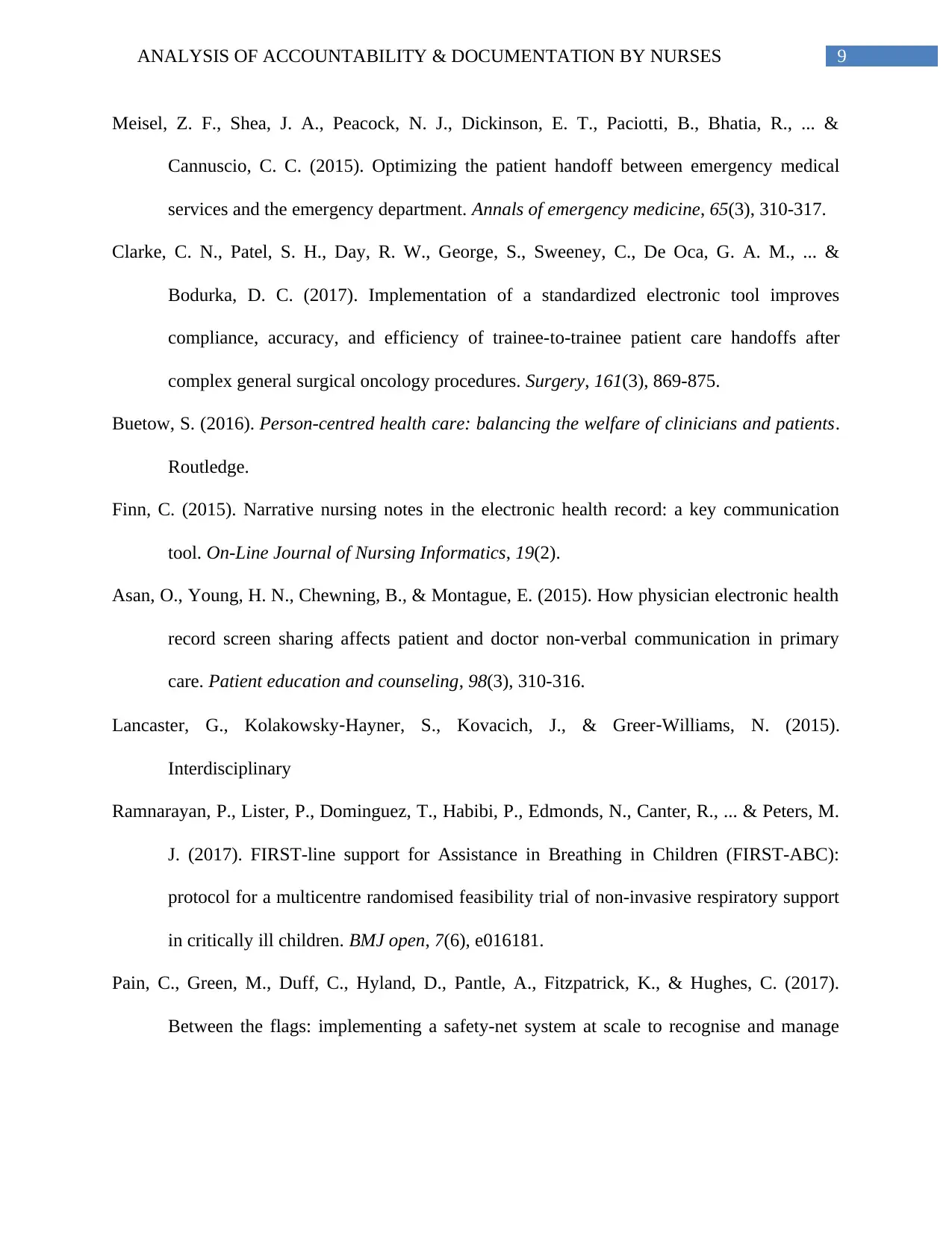
9ANALYSIS OF ACCOUNTABILITY & DOCUMENTATION BY NURSES
Meisel, Z. F., Shea, J. A., Peacock, N. J., Dickinson, E. T., Paciotti, B., Bhatia, R., ... &
Cannuscio, C. C. (2015). Optimizing the patient handoff between emergency medical
services and the emergency department. Annals of emergency medicine, 65(3), 310-317.
Clarke, C. N., Patel, S. H., Day, R. W., George, S., Sweeney, C., De Oca, G. A. M., ... &
Bodurka, D. C. (2017). Implementation of a standardized electronic tool improves
compliance, accuracy, and efficiency of trainee-to-trainee patient care handoffs after
complex general surgical oncology procedures. Surgery, 161(3), 869-875.
Buetow, S. (2016). Person-centred health care: balancing the welfare of clinicians and patients.
Routledge.
Finn, C. (2015). Narrative nursing notes in the electronic health record: a key communication
tool. On-Line Journal of Nursing Informatics, 19(2).
Asan, O., Young, H. N., Chewning, B., & Montague, E. (2015). How physician electronic health
record screen sharing affects patient and doctor non-verbal communication in primary
care. Patient education and counseling, 98(3), 310-316.
Lancaster, G., Kolakowsky‐Hayner, S., Kovacich, J., & Greer‐Williams, N. (2015).
Interdisciplinary
Ramnarayan, P., Lister, P., Dominguez, T., Habibi, P., Edmonds, N., Canter, R., ... & Peters, M.
J. (2017). FIRST-line support for Assistance in Breathing in Children (FIRST-ABC):
protocol for a multicentre randomised feasibility trial of non-invasive respiratory support
in critically ill children. BMJ open, 7(6), e016181.
Pain, C., Green, M., Duff, C., Hyland, D., Pantle, A., Fitzpatrick, K., & Hughes, C. (2017).
Between the flags: implementing a safety-net system at scale to recognise and manage
Meisel, Z. F., Shea, J. A., Peacock, N. J., Dickinson, E. T., Paciotti, B., Bhatia, R., ... &
Cannuscio, C. C. (2015). Optimizing the patient handoff between emergency medical
services and the emergency department. Annals of emergency medicine, 65(3), 310-317.
Clarke, C. N., Patel, S. H., Day, R. W., George, S., Sweeney, C., De Oca, G. A. M., ... &
Bodurka, D. C. (2017). Implementation of a standardized electronic tool improves
compliance, accuracy, and efficiency of trainee-to-trainee patient care handoffs after
complex general surgical oncology procedures. Surgery, 161(3), 869-875.
Buetow, S. (2016). Person-centred health care: balancing the welfare of clinicians and patients.
Routledge.
Finn, C. (2015). Narrative nursing notes in the electronic health record: a key communication
tool. On-Line Journal of Nursing Informatics, 19(2).
Asan, O., Young, H. N., Chewning, B., & Montague, E. (2015). How physician electronic health
record screen sharing affects patient and doctor non-verbal communication in primary
care. Patient education and counseling, 98(3), 310-316.
Lancaster, G., Kolakowsky‐Hayner, S., Kovacich, J., & Greer‐Williams, N. (2015).
Interdisciplinary
Ramnarayan, P., Lister, P., Dominguez, T., Habibi, P., Edmonds, N., Canter, R., ... & Peters, M.
J. (2017). FIRST-line support for Assistance in Breathing in Children (FIRST-ABC):
protocol for a multicentre randomised feasibility trial of non-invasive respiratory support
in critically ill children. BMJ open, 7(6), e016181.
Pain, C., Green, M., Duff, C., Hyland, D., Pantle, A., Fitzpatrick, K., & Hughes, C. (2017).
Between the flags: implementing a safety-net system at scale to recognise and manage
Secure Best Marks with AI Grader
Need help grading? Try our AI Grader for instant feedback on your assignments.
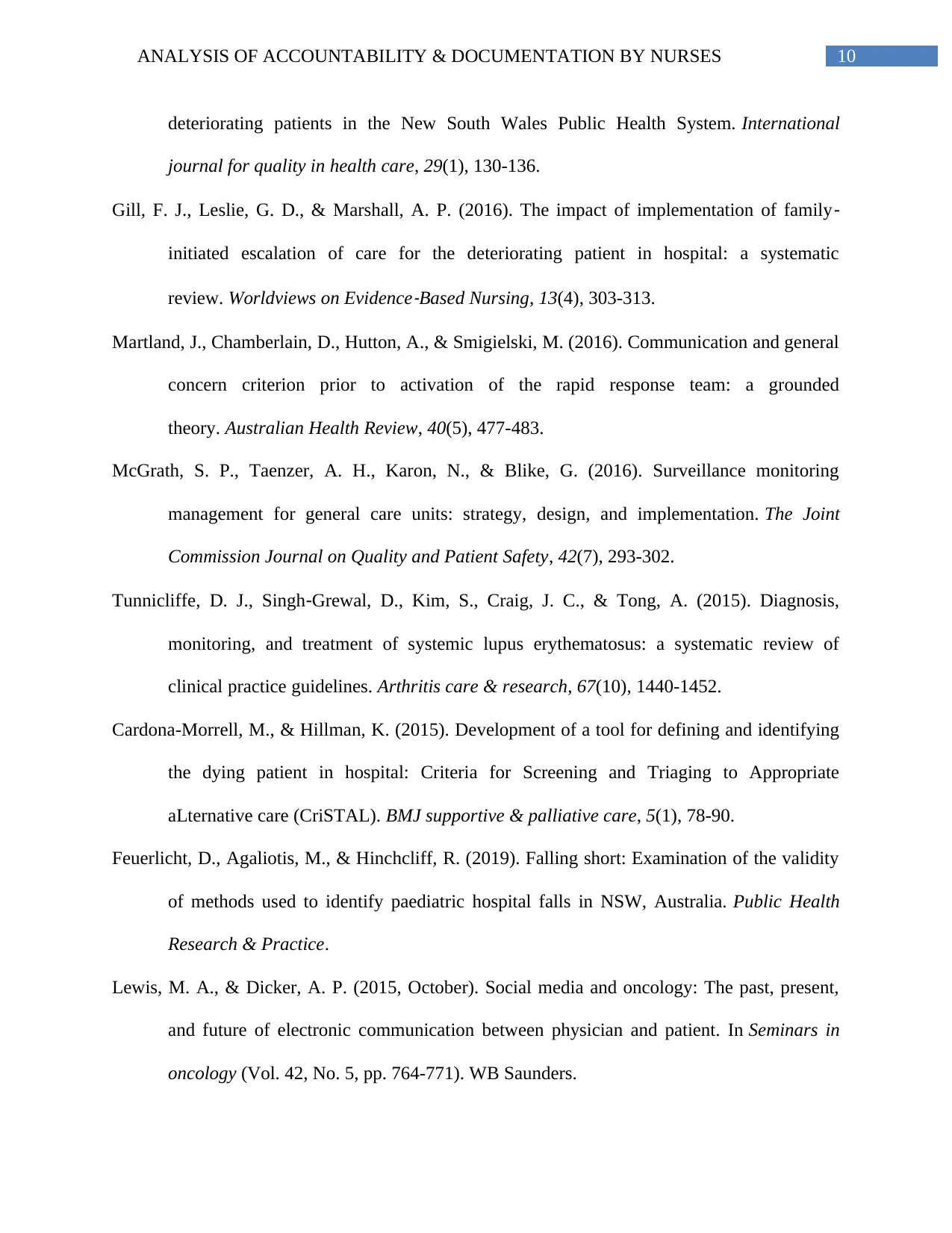
10ANALYSIS OF ACCOUNTABILITY & DOCUMENTATION BY NURSES
deteriorating patients in the New South Wales Public Health System. International
journal for quality in health care, 29(1), 130-136.
Gill, F. J., Leslie, G. D., & Marshall, A. P. (2016). The impact of implementation of family‐
initiated escalation of care for the deteriorating patient in hospital: a systematic
review. Worldviews on Evidence
‐Based Nursing, 13(4), 303-313.
Martland, J., Chamberlain, D., Hutton, A., & Smigielski, M. (2016). Communication and general
concern criterion prior to activation of the rapid response team: a grounded
theory. Australian Health Review, 40(5), 477-483.
McGrath, S. P., Taenzer, A. H., Karon, N., & Blike, G. (2016). Surveillance monitoring
management for general care units: strategy, design, and implementation. The Joint
Commission Journal on Quality and Patient Safety, 42(7), 293-302.
Tunnicliffe, D. J., Singh‐Grewal, D., Kim, S., Craig, J. C., & Tong, A. (2015). Diagnosis,
monitoring, and treatment of systemic lupus erythematosus: a systematic review of
clinical practice guidelines. Arthritis care & research, 67(10), 1440-1452.
Cardona-Morrell, M., & Hillman, K. (2015). Development of a tool for defining and identifying
the dying patient in hospital: Criteria for Screening and Triaging to Appropriate
aLternative care (CriSTAL). BMJ supportive & palliative care, 5(1), 78-90.
Feuerlicht, D., Agaliotis, M., & Hinchcliff, R. (2019). Falling short: Examination of the validity
of methods used to identify paediatric hospital falls in NSW, Australia. Public Health
Research & Practice.
Lewis, M. A., & Dicker, A. P. (2015, October). Social media and oncology: The past, present,
and future of electronic communication between physician and patient. In Seminars in
oncology (Vol. 42, No. 5, pp. 764-771). WB Saunders.
deteriorating patients in the New South Wales Public Health System. International
journal for quality in health care, 29(1), 130-136.
Gill, F. J., Leslie, G. D., & Marshall, A. P. (2016). The impact of implementation of family‐
initiated escalation of care for the deteriorating patient in hospital: a systematic
review. Worldviews on Evidence
‐Based Nursing, 13(4), 303-313.
Martland, J., Chamberlain, D., Hutton, A., & Smigielski, M. (2016). Communication and general
concern criterion prior to activation of the rapid response team: a grounded
theory. Australian Health Review, 40(5), 477-483.
McGrath, S. P., Taenzer, A. H., Karon, N., & Blike, G. (2016). Surveillance monitoring
management for general care units: strategy, design, and implementation. The Joint
Commission Journal on Quality and Patient Safety, 42(7), 293-302.
Tunnicliffe, D. J., Singh‐Grewal, D., Kim, S., Craig, J. C., & Tong, A. (2015). Diagnosis,
monitoring, and treatment of systemic lupus erythematosus: a systematic review of
clinical practice guidelines. Arthritis care & research, 67(10), 1440-1452.
Cardona-Morrell, M., & Hillman, K. (2015). Development of a tool for defining and identifying
the dying patient in hospital: Criteria for Screening and Triaging to Appropriate
aLternative care (CriSTAL). BMJ supportive & palliative care, 5(1), 78-90.
Feuerlicht, D., Agaliotis, M., & Hinchcliff, R. (2019). Falling short: Examination of the validity
of methods used to identify paediatric hospital falls in NSW, Australia. Public Health
Research & Practice.
Lewis, M. A., & Dicker, A. P. (2015, October). Social media and oncology: The past, present,
and future of electronic communication between physician and patient. In Seminars in
oncology (Vol. 42, No. 5, pp. 764-771). WB Saunders.

11ANALYSIS OF ACCOUNTABILITY & DOCUMENTATION BY NURSES
1 out of 12
Related Documents
Your All-in-One AI-Powered Toolkit for Academic Success.
+13062052269
info@desklib.com
Available 24*7 on WhatsApp / Email
![[object Object]](/_next/static/media/star-bottom.7253800d.svg)
Unlock your academic potential
© 2024 | Zucol Services PVT LTD | All rights reserved.




